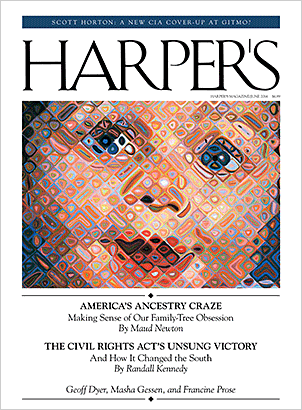Introducing the June 2014 Issue
Maud Newton reflects on America’s ancestry obsession, Randall Kennedy revisits the Civil Rights Act, Scott Horton reveals a possible coverup at Guantánamo Bay, and more
 When I walk through the doorway to my house, the first thing I see is a wall of my ancestors depicted in old photographs, some of them from a century ago. These family members — grandfathers and grandmothers, great aunts and uncles, my mother and father as infants — give me a sense of where I’ve come from. And that’s somehow reassuring in an era when everyone seems to value newness over the past. In fact, this very sense of historical alienation may have fueled a renewed interest in genealogy, a phenomenon explored by Maud Newton in our June 2014 cover story, “America’s Ancestry Craze.” You can now send samples of your DNA to websites such as Ancestry.com and 23andMe, and for about a hundred dollars the sites will analyze your genetic history and put you in touch with people who are likely relatives. Has the riddle of identity been solved, then? Not exactly. Since a family tree’s branches tend to expand until everyone is related to everyone else, Newton suggests that the answer to who we are may lie more in philosophy than in genealogy.
When I walk through the doorway to my house, the first thing I see is a wall of my ancestors depicted in old photographs, some of them from a century ago. These family members — grandfathers and grandmothers, great aunts and uncles, my mother and father as infants — give me a sense of where I’ve come from. And that’s somehow reassuring in an era when everyone seems to value newness over the past. In fact, this very sense of historical alienation may have fueled a renewed interest in genealogy, a phenomenon explored by Maud Newton in our June 2014 cover story, “America’s Ancestry Craze.” You can now send samples of your DNA to websites such as Ancestry.com and 23andMe, and for about a hundred dollars the sites will analyze your genetic history and put you in touch with people who are likely relatives. Has the riddle of identity been solved, then? Not exactly. Since a family tree’s branches tend to expand until everyone is related to everyone else, Newton suggests that the answer to who we are may lie more in philosophy than in genealogy.
In 1964, when the Civil Rights Acts was passed, it promised change, particularly in those Southern states where change was slow to come. I was in college in Maryland at the time, and coming from New York City, I was startled to find that African-Americans were confined to sitting in the balcony of the local movie theater, and that drinking fountains were still designated “white” and “colored.” The Civil Rights Act promised to end segregated access to public accommodations, declaring that all persons “shall be entitled to the full and equal enjoyment” of such facilities. In celebration of the act’s fiftieth anniversary, Randall Kennedy considers its impact in light of his own experiences as a child traveling with his parents through the segregated South of the 1960s. The act may have failed to relieve discrimination in such important areas as education and employment, but it was nonetheless a huge symbolic achievement, argues Kennedy, mandating a policy of racial inclusion.
Scott Horton revisits the supposed detainee “suicides” that took place at Guantánamo Bay Naval Base in 2006. New documents included in a Naval Criminal Investigative Service (NCIS) report, and uncovered recently through the Freedom of Information Act, punch even more holes in the official story, while suggesting that the prisoners were likely tortured to death in an effort to “turn” them into intelligence assets.
In “Northern Exposure,” Masha Gessen, the author of a much-acclaimed book about Vladimir Putin, reviews the case of the Arctic 30, a group of Greenpeace activists arrested and jailed by the Russian president on the spurious charge of piracy. It was dangerous, the activists learned, to antagonize Gazprom, the state’s energy monopoly — and even more dangerous to challenge Putin’s dream of a Russian Arctic. Although the activists were released just before the Olympics began in Sochi, their experience was an education in the brutality and corruption of Russia’s prison system.
Scott Korb’s father was killed by a drunk driver when he and his family were on holiday in Florida in 1982. Because almost no event in his life has affected him so profoundly, the author decided to search for the culprit. After repeated trips to Florida and many hours spent poring over newspaper stories and police reports, Korb eventually confronted the man — and found himself pondering at least the possibility of mutual redemption: “Without hope for another world,” he writes, “Christianity has become for me about forgiveness in this one.”
In another poignant excursion into the past, Geoff Dyer and the photographer Chloe Dewe Mathews revisit the Europe of World War I, which began nearly a hundred years ago, in July 1914. The images are part of a series called Shot at Dawn, for which Dewe Mathews visited sites where soldiers were executed for desertion or cowardice in the face of the enemy. She took the photographs as close to the time of day that the executions took place as possible — usually at dawn or dusk — and the muted, mostly bucolic scenes make conspicuous what is absent: the dead.
Also in this issue: Hilton Als on his experience of islands; Gideon Lewis-Kraus on a hole-digging competition in Japan; James Marcus on the failure of border fencing to solve our immigration problem; and a new short story by Daniel Mason.


